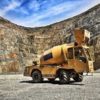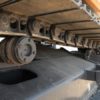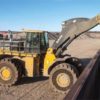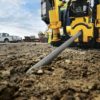International lithium: all bets are on the Argentine Salares
Latin America is not the only place with lithium rich brines and salt-pans but it was the focus of the first wave of de novo attention on the lithium space in 2009. In the first flush of lithium enthusiasm the mid-Andean region became a hot spot for its ample resource of lithium/potassium brine lakes, called salares by the locals.
The Puna plateau, covers a portion of Argentina, Chile and Bolivia. It is at an elevation of around 4,000m and contains the largest concentration of economic evaporate deposits in the world. The evaporate deposits are formed by intense evaporation under hot dry air in a closed basin. The brine, under the crust formed on the surface of the salt lakes, contains high concentrations of sodium, lithium, potassium, magnesium and boron (the major element of borax).
Also interesting in the LatAm lithium lakes is the associated potash deposits.
The Argentine Salares
There are around 50 salares located within the Antofallos-Pocitos volcanic rift valley in the high Andean plain.
On the Argentine side of the border there are a couple of currently producing deposits:
FMC Corp.’s Fenix brine complex located on Salares Hombre Muerto in Argentina contains high uniform concentrations of lithium with low levels of other contaminants and is the fifth largest lithium producer in the world
Orocobre’s Tincalayu complex (bought from RTZ) also located on Salares Hombre Muerto in Argentina and is South America’s largest borate mining operation
Orocobre’s Olaroz project which has been threatening to get into commercial production for several years and has recently achieved the goal after many slips along the way.
One thing worth noting also is the partial ownership that many of the players have in their salares. Owning part of a salt-pan is rather clear cut as the material to be excavated is solid. However, in a brine lake the first mover gets the distinct advantage of being able to take out the best material before the slowpokes can do anything about it. The brines have different densities (and thus different grades) at different depths. Draining the best densities is not a task that respects theoretical lines on the surface of a liquid body. This is similar to a common problem in the oil industry but in this case, it seems to us almost more egregious.
The processing of output from salares
All mining is a chemical process to some degree. The production of lithium and its by-products are more chemical than most mining processes. Firstly the brines are evaporated in lined evaporating ponds. The evaporation rate at high-level salares can be around 3,000mm per annum (this depends most upon the number of cloudless days per annum at any given site). Then the output from the salar requires the selective precipitation of calcium and magnesium cations (positively charged ions) that interfere in the recovery of lithium of sufficient quality. These cations are precipitated in a two-step pre-treatment process:
Mg++ + Ca(OH) 2 → Mg(OH) 2 [insoluble] + Ca++
Ca++ + Na 2SO 4 → CaSO 4 [insoluble] + 2Na+
These pre-treatments require the input of lime. This is a key ingredient and the supply of this input is one of the most onerous conditions of the process. To produce 15,000 tpa of LiCl will require approximately 84,000 tpa of sodium sulphate.
Extraction process
The brine passes through a series of evaporation ponds (phases B, C & D above). These are all of one metre in depth. Then the potash is extracted at the concentrated brine phase (E). Finally, the ionization plant (at phase F) creates the finished chemicals for bagging and then export.
In some brine lakes magnesium (at phase C) can be produced as a by-product. However, in some cases this byproduct is of no economic value. It is widely commented that Magnesium (Mg) levels are deleteriously high in the Bolivian salares making them less attractive than those further south in the Andes. However, we suspect this is somewhat sour grapes as Magnesium has economic value. The Bolivians have just started shipping this supposedly “unsellable” product to the Chinese.
Mariana
One project with which we have had an enduring relationship is the Argentine property held by International Lithium Corp. (TSXV: ILC). International Lithium is an exploration company with (not unsurprisingly) an international spread of projects and a strategic partner/investor, Ganfeng, a leading Chinese lithium product manufacturer.
The primary focus is the Mariana lithium-potash brine project, a joint venture with Ganfeng Lithium within the aforementioned Lithium Triangle. The 160-square kilometre Mariana project strategically encompasses an entire mineral rich evaporate basin (the Salar de Llullaillaco) that the company ranks as one of the more prospective salares. This salar is shown on the map earlier in this piece and is the most westerly and right up near the Chilean border and directly south of the famed Salar de Atacama on the Chilean side (not shown).
The Ganfeng Deal
While the Mariana project is the main game for International Lithium, it and its strategic partner Ganfeng Lithium have finalized two separate agreements. The Mariana deal was announced back in March 2014 and consisted of a loan conversion and investment agreement on the Argentine project in exchange for work commitments and the cancellation of approximately US$3.3 million in loans plus interest indebted to Ganfeng.
At the same time the parties finalized their joint venture agreement for operation of the Blackstairs lithium pegmatite project in Ireland. The aggregate work commitment on both projects was to be approximately $20 million.
The resultant ownership of the Blackstairs project was to be 51percent Ganfeng Lithium and 49percent International Lithium until the CAD$10 million expenditures are reached or a positive feasibility study is produced for the project at which time the ownership will be 75percent Ganfeng Lithium and 25percent International Lithium.
The resultant ownership of the Mariana project should work out to be 80percent Ganfeng and 20percent International Lithium. International Lithium has a back-in right to acquire an additional 10percent in the project following the completion of a Feasibility Study that demonstrates the feasibility of placing the Mariana Project into commercial production. Additionally, Ganfeng granted International Lithium a loan for up to $2 million to carry International Lithium’s participating interest in the project, which if fully executed will amount to a total of US$10 million being expended on the project. The loan (and any accrued interest) is repayable from International Lithium’s proportionate share of the proceeds from the joint venture.
Ganfeng clearly want to have a number of horses running the Lithium Stakes. This might seem surprising in light of their strong role at the more advanced Mt Marion project in Australia but it should be recalled that Neometals Ltd. (ASX: NMT) (and Minproc) cut a very canny deal with Ganfeng that limits the Chinese take of the output after a certain point. Thus, Ganfeng will be needing some backup production in that eventuality and clearly International Lithium is the anointed one.
Conclusion
Latin American brines have gone from the pole position in 2010 to having to battle it out for investor attention in 2016 between spodumene, brines and clays. The initial advantage was let slip when companies like Orocobre (with Olaroz) and Sentient (with Rincon) failed to deliver on what had been presented to investors as a relative “no-brainer”. Fill the pond, evaporate, scoop it up. Something went wrong in the process with Orocobre and Sentient and the delivery was well under par.
Finally, Orocobre is in commercial production and the Second Wave of the Lithium phenomenon has brought attention back to the Latin American salares. It certainly helps that Argentina has also come out of the political penalty box with its Presidential elections in late 2015 that rid us of the Kirchner curse. However, Lithium had not particularly suffered from any discrimination under the old regime, it was just that La Presidenta’s lingering presence was a scarecrow to potential investors.
Ganfeng are having a spread bet across continents and across mineralogies in backing Neometals with its spodumene in Australia and International Lithium with its brines in Argentina and pegmatite in Ireland. The difference is far is that Neometals has delivered investors a ten-bagger with International Lithium still remains lower down the development curve. If Ganfeng want to make their spreadbet work for them then International Lithium is the obvious collateral beneficiary of such a push.
fuente: http://www.miningglobal.com/operations/2134/International-lithium:-all-bets-are-on-the-Argentine-Salares
